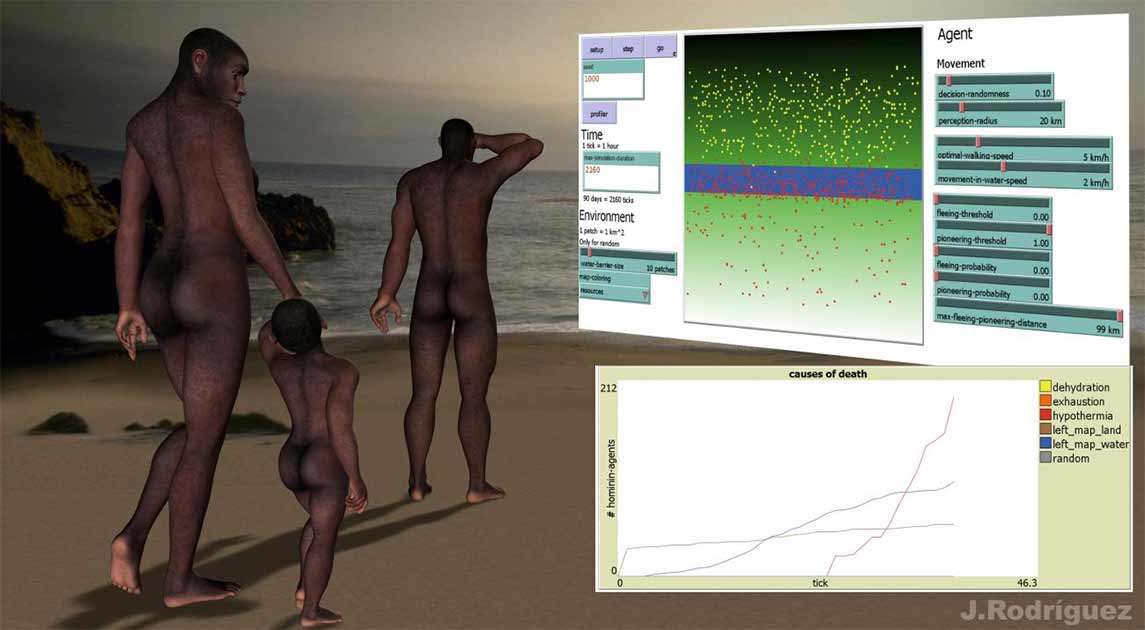Study: How Pleistocene Hominins Crossed The Seas A Million Years Ago
A team of German and Spanish researchers has published a new computational model demonstrating how Pleistocene hominins crossed the sea and sea straits between one and two million years ago.
Pleistocene hominins occupied Flores about 850,000 years ago. This means the technological, cultural and cognitive development required to have travelled across Eurasia was present in Pleistocene hominin cultures, between one and two million years ago.
The big debate in recent years has been “ how” these first migrating hominins left Africa. Recently, a scientific study by German and Spanish researchers has suggested a whole new range of possibilities and requirements for how early prehistoric people crossed large bodies of water.

This figure from the recent study clearly shows the four ways Pleistocene hominins could have crossed large bodies of water, like the straits between Africa and Spain or those in Indonesia. The four ways were: floating with nothing, swimming, floating while hanging on to a log, and the technologically advanced concept of the raft. (PLOS ONE)
Pleistocene Hominins May Have Left Africa By Land and Sea
The new research was conducted by scientists at the National Center for Research on Human Evolution (CENIEH). A paper published in the journal PLOS ONE by professors Ana Mateos and Jesús Rodríguez, presents a new computational model showing how Pleistocene hominins might have crossed narrow straits over a million years ago.
- Pleistocene Epoch: Humans, Welcome to Earth
- Last Hominin Standing: Extreme Adaptation of Late Pleistocene Humans
Did the first waves of hominin dispersion from Africa follow longer overland routes? Or did the early humans manage to cross narrow sea straits like at Gibraltar in the Mediterranean Sea?
Only in July this year (2021) Prof. Robert G. Bednarik from Hebei Normal University published a study saying the “first known sea travel by humans occurred by raft in the Lower Pleistocene.” His study refers to how humans might have crossed the Lombok Strait between the Indonesian islands of Bali and Lombok.

Like this troop of Bonobo chimpanzees in Africa, Pleistocene hominins were socially characterized by group dynamics and alpha leaders, and both played a role in successful sea crossings according to the recent study. (Uryadnikov Sergey / Adobe Stock)
The New Study Simulated Group Dynamics To Learn More
Other authors in this field have previously presented much cruder computational models attempting to chart the first waves of hominid dispersion. However, according to the new paper, all previous studies, (apart from Dr. Bednarik’s July paper) “always considered the sea as an insurmountable barrier.” The team of German and Spanish scientists now have presented a new model simulating “the behavior” within a group of hominins.
The researchers tested hypothetical groups of hominids in what they call “a hypothetical landscape” equipped with two conceptual banks, separated by a theoretical strait of water. The success of the crossing was determined by the group successfully establishing a stable population on the other bank. This means the entire analysis was based not so much on landscape features, and topographical restrictions, but leaned more into the importance of group dynamics.

There were a limited number of ways to cross large bodies of water and all of them in the Pleistocene would have been incredibly dangerous. Likely there were many failures before any successes. (Dennis Cox / Adobe Stock)
The Serious Challenges Of Sea Travel Millions of Year Ago!
How individuals interacted within the group setting, in any given environment, were reproduced by the computer model. Then, the programming team accounted for topographical, physiological, and demographic factors, which all greatly affect outcomes, successful or otherwise.
First, to satisfy skeptics Dr Jesús Rodriguez calculated that the probability of success of accidentally crossing a strait to establish a founding population “is very low.” He explained that successful colonization “on the other side” needed several individuals.
All this was tested against “four types of movement in the water.” The experiment tested two active and directional water crossing (swimming, and floating on a raft), and two passive and without direction methods (letting yourself be dragged adrift with or without using an object as a float). Dr Ana Mateos said many other variables were built into the model including the physiological risks that hominids would have faced during Pleistocene sea crossing, including “dehydration, hypothermia and exhaustion.”

Pleistocene hominins evolved and were increasingly characterized by the influence of individual decision makers and breakthrough individuals and the latest study also touches on this. (Xavier / Adobe Stock)
The Presence of A Strong Decision Maker Was Also Key
When the go button was pressed on the computer model the results demonstrated how hominids “could have crossed distances of less than 10 km [6 miles], simply by swimming.” However, the swimmers would have been exposed to exceptionally cold-water temperatures for extended periods of time, increasing the threat of hypothermia. The model showed that wooden rafts would allow longer journeys. However, starvation and dehydration leading to death were identified as high-risk factors.
- Pleistocene Skull and 300,000 Years of Evolution Secrets Found in a Chinese Cave
- Study Says Hominids May Have Entered Europe Via the Strait of Gibraltar 900,000 Years Ago
What is perhaps the most fascinating aspect of the new study is that a major factor for successful sea-navigation and resettlement was the presence of “a strong decision-maker.” When a team of early travelers had a conceptual captain, the “directionality of the groups movement increased.” This means, a group fared better with an experienced decision-making individual who was able to choose the right way forward as these earliest of peoples attempted to cross sea straits all over the world.
Top image: A family of Pleistocene hominins on the beach was the poster image used by Spain’s National Center for Research on Human Evolution (CENIEH) for their research into prehistoric human migrations that required crossing large bodies of water, especially sea straits. Source: CENIEH
By Ashley Cowie



















